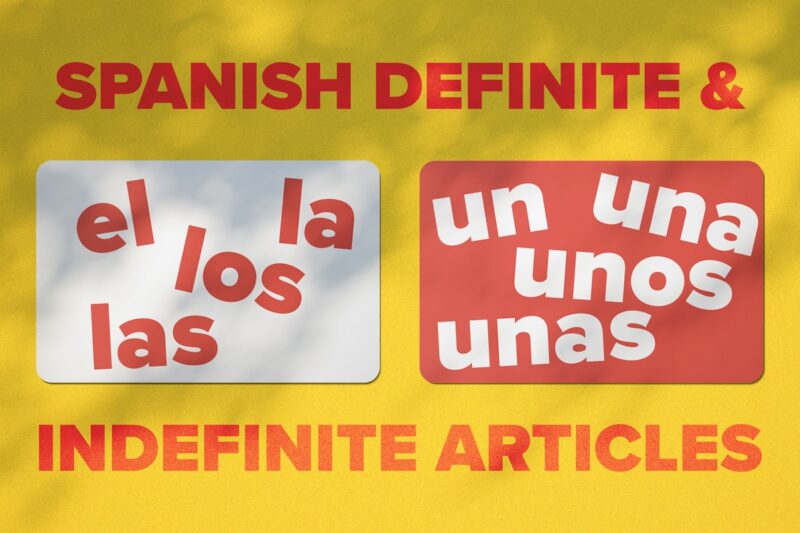Definite and Indefinite Articles in Spanish

Articles are small but extremely common words that come before specific and general nouns—in English, they’re words like “the” and “an.” Definite and indefinite articles in Spanish are words like el, la, los, las, lo, un, una, unos and unas.
In this post, you’ll learn exactly what they are, how they work, when to use them and more. We also have a lesson on our YouTube channel for extra practice:
Download: This blog post is available as a convenient and portable PDF that you can take anywhere. Click here to get a copy. (Download)
Definite and Indefinite Articles in Spanish
Articles are words that refer to nouns. The English articles are “a,” “an,” “the” and “some.”
“The” is a definite article because it refers to a specific object:
Pass me the salt.
The car is around the corner.
“A,” “an” and “some” are indefinite articles because they refer to a general object rather than a specific object:
She has an older brother.
There’s some cheese in the refrigerator.
In Spanish, the definite article has four forms: el, la, los and las.
When deciding which form to use, you must first identify the quantity and gender of your noun.
For a run-down of Spanish gender, click here. Likewise, here’s an overview of Spanish plurals. If you’re already familiar with these two concepts, read on.
Here are the definite articles in Spanish and examples of how they’re used:
| Spanish | English | Example |
|---|---|---|
| El | The (Singular, Masculine) | El coche (the car) |
| La | The (Singular, Feminine) | La muchacha (the girl) |
| Los | The (Plural, Masculine) | Los ojos (the eyes) |
| Las | The (Plural, Feminine) | Las letras (the letters) |
Now, let’s look at indefinite articles.
The Spanish indefinite articles are un, una, unos and unas. Just like the definite articles, each corresponds to a gender and a number.
| Spanish | English | Example |
|---|---|---|
| Un | A/an (Singular, masculine) | Un perro (a dog) |
| Una | A/an (Singular, feminine) | Una semana (a week) |
| Unos | Some (Plural, masculine) | Unos estudiantes (some students) |
| Unas | Some (Plural, feminine) | Unas mesas (some chairs) |
When to Use Definite Articles in Spanish
1. To Talk About Likes and Dislikes
In English, when talking about our likes, loves and dislikes, we don’t generally use articles (like in the sentences “I like monster trucks” or “I hate black olives.”)
But in Spanish, you must use definite articles (el, la, los, las) when talking about these general likes and dislikes.
Me gusta el arte. (I like art.)
Odio las películas de terror. (I hate horror movies.)
2. To Tell Time
Times in Spanish are all feminine, and you must always include the feminine definite article (la or las) when telling time.
When learning to tell time in Spanish, there are two important phrases to remember:
Son las… (it’s)
A las… (at)
For example:
Son las ocho de la mañana. (It’s 8:00 in the morning.)
El concierto empieza a las diez y media. (The concert begins at 10:30.)
The only exception to son las and a las is when you’re talking about the hour 1:00 because one is singular. So naturally, you’d use the singular feminine article la:
Voy a llegar a la una y veinte. (I’ll arrive at 1:20.)
¡Ya es la una y cuarto! (It’s already a quarter past 1!)
El partido terminó a la una menos diez. (The game ended at 10 to 1.)
3. With Days of the Week
In English, we’re used to using prepositions before saying a day of the week. For example:
I hope to see you on Thursday.
She won’t be here until Friday night.
But in Spanish, when you want to talk about something happening on a specific day of the week, you must use a definite pronoun before the day.
The days of the week are always masculine, so you’ll use either el or los.
When talking about one specific day of the week, use el:
Iré a Bogotá el lunes que viene. (I will go to Bogota next Monday.)
When talking about something habitual or that happens every week, use los:
Voy al gimnasio todos los martes. (I go to the gym every Tuesday.)
Visito a mi abuela todos los miércoles. (I visit my grandmother every Wednesday.)
4. To Talk About General Things
In English, we’re used to dropping the definite article (“the”) when talking about nouns in general. For example, if you think all dogs are cute (generally), you’d say “Dogs are cute.”
But in Spanish, we keep the definite article.
Take a look at these sentences as examples:
Los perros son lindos. (Dogs are cute.)
La comida india es picante. (Indian food is spicy.)
Me gusta el café. (I like coffee.)
5. With Reflexive Verbs
You’ll see this all the time with reflexive verbs—actions that you do to yourself.
For example, in English we say “I wash my hands,” but in Spanish, we say “I wash the hands”:
Me lavo las manos. (I wash my hands.)
Me lavo el pelo. (I wash my hair.)
Me duele la cabeza. (My head hurts.)
Here’s a bit more challenging sentence that uses the reflexive verb irse (to leave):
Si tú te vas, se me irá todo el valor. (If you leave, all my courage will leave me.)
This is a lyric from the song “Si Tú Te Vas” (If You Leave), a popular love song by Enrique Iglesias. Notice how he doesn’t literally say my courage—he says the courage will leave me.
You can listen to Spanish songs like this one on FluentU, where the music video has interactive subtitles that help you spot instances of definite and indefinite articles in context.
FluentU takes authentic videos—like music videos, movie trailers, news and inspiring talks—and turns them into personalized language learning lessons.
You can try FluentU for free for 2 weeks. Check out the website or download the iOS app or Android app.
P.S. If you decide to sign up now, you can take advantage of our current sale!

There’s also the FluentU Spanish YouTube channel, where you can find Spanish-dubbed clips of popular TV shows and movies turned into in-depth lessons.
6. When Talking About Someone’s Title
This is another deviation from English, where we simply say “Dr. Smith” or “Professor Jones.”
In Spanish, titles require a definite article before them, even when you’re not saying the doctor or the professor. This also applies to titles like “Mr.” and “Mrs.”
For example:
La profesora Garcia llega a las ocho. (Professor Garcia arrives at eight o’clock.)
El doctor Ibarra es rico. (Dr. Ibarra is rich.)
El señor Hernandez trabaja en la empresa. (Mr. Hernandez works at the company.)
7. To Say the Names of Languages
When a language is the subject of a sentence—the thing being talked about—it needs a definite article. For example:
El ruso es el más dificil idioma que he estudiado. (Russian is the most difficult language I have studied.)
El español y el japonés son mis idiomas favoritos. (Spanish and Japanese are my favorite languages.)
However, when a language is the object, you don’t need to use the article. For example:
Yo hablo inglés. (I speak English.)
When To Use Indefinite Articles in Spanish
1. To Place Emphasis on a Word
In Spanish, we frequently use the verb tener (to have) to express states of being.
For example, tener frío (to be cold), tener calor (to be hot), tener sed (to be thirsty), tener dolor (to be hurt), tener prisa (to be in a hurry), tener suerte (to be lucky) and so on.
With many of these expressions, you can insert the correct indefinite article (un, una) to add emphasis or urgency in colloquial settings.
Tengo un frío… odio el invierno, tío. (I’m so cold… I hate winter, dude.)
You also must add the indefinite article if you want to qualify the state of being with an adjective or with more information:
Tengo un poco de calor. (I’m a little hot.)
Tengo una prisa terrible, lo siento mucho. (I’m in an awful hurry, I’m really sorry.)
Just be careful with tener sueño (to be sleepy).
If you add the indefinite article, you can sound super inspirational instead of super tired—tengo un sueño can mean “I have a dream.” You’ll indicate what you mean through intonation.
2. When Listing One Noun Out of a Group
We have to use the indefinite article when talking about an unspecified person or object inside a group.
This happens because we randomly pick up one item from the group as an example to represent all of the items in the group.
For example:
Un cocinero es una persona que cocina. (A cook is a person who cooks.)
Un libro puede tener muchas páginas. (A book can have many pages.)
We are not talking about a specific cook called Gordon who lives in Manhattan. We’re talking about an unidentified cook representing the whole group of cooks worldwide.
3. To Describe People or Things with Nouns
When describing people with a noun, you’ll need to use an indefinite article.
The majority of times, we’ll use a masculine noun (and the corresponding masculine article) even for describing women.
For example:
Eres un sol. (You are a sweetie. Literally, “You are a sun.” This can be applied to both men and woman and it does not need a change in gender).
Son unos locos. (You all/they are crazy people.)
We also have to use the indefinite article when we describe something or someone by using a noun and an adjective:
Ana es una mujer muy guapa. (Ana is a very beautiful woman.)
Esta rosa es una flor delicada. (This rose is a delicate flower.)
El cáncer es una enfermedad muy peligrosa. (Cancer is a very dangerous disease.)
4. To Say There’s Only One
Another situation when we use the indefinite article is identical both in Spanish and English—when we are talking about a single unit (one) of something (or of somebody, as you will see in the examples).
It doesn’t matter if you’re talking about something known or unknown, specified or not.
If you have only one of them, you have to use the indefinite article un/una:
He comprado tan solo un regalo. (I have only bought one present.)
Hay un niño en la cocina. (There is one child in the kitchen.)
Tengo una hermana. (I have one sister.)
5. To Express Approximate Amounts
As we saw before, the Spanish indefinite article has two plural forms (unos, unas). With the meaning of “some/a few,” we are obviously going to use them when talking about approximate amounts of things or people!
Here you have some examples:
Necesito unas monedas. (I need some coins.)
Compra unas manzanas. (Buy a few apples.)
Hay unos gatos en el tejado. (There are some cats on the roof.)
Notes About Using Articles in Spanish
Omit Them When Talking About an Unspecified Quantity
In English, when we talk about an unspecified quantity of something—or when we’re dealing with uncountable nouns—we generally use the qualifiers “some” or “any.”
(For example, “There isn’t any bread on the table” or “I have some green shirts in my closet.”)
Resist the urge to translate directly from English to Spanish!
In Spanish, you don’t need to use an article when talking about an indefinite amount or using an uncountable noun:
Hay leche en el vaso. (There’s some milk in the glass.)
No hay coches en el estacionamiento. (There aren’t any cars in the parking lot.)
Omit Them When Talking About Your Profession, Nationality, Religion, Etc.
In English, we use the indefinite articles a or an when talking about our professions, nationalities, religions and the other labels that make up our identities.
(For example, “I’m an anthropologist” or “She’s a Catholic.”)
In Spanish, you must leave those articles out:
Soy abogado. (I’m a lawyer.)
Soy brasileña. (I’m a Brazilian.)
However, if you wish to qualify that abstract concept with more information, you usually need to insert an indefinite article (un, una):
Soy un buen doctor. (I’m a good doctor.)
Soy un católico con mucha fe. (I’m a Catholic with a lot of faith.)
Feminine Nouns Starting with “A” Use the El Article
As we’ve learned, a singular, feminine noun always uses the article la.
However, the article will switch to el when the noun starts with the letter a, and the stress of the word also falls on that vowel. This is the case with words like agua (water), alma (soul) and arma (weapon).
This exception exists to avoid the awkwardness of having two a’s next to each other. For example:
(La) águila → el águila (the eagle)
However, because this rule only exists to avoid having two a’s next to each other, if you’re using the plural form of the noun, you can switch back to the feminine article:
Las águilas (the eagles)
Additionally, if there’s an adjective in between the article and the noun, you can use the feminine article la:
La gran águila (the big eagle)
And, of course, remember that any associated adjective must be feminine even if you use the article el:
El águila blanca (the white eagle)
With these 12 rules in mind, you’ll be using definite and indefinite articles easily in no time.
Not to mention, you’ll also pick them up naturally when interacting with native speakers and watching Spanish media.
So don’t shy away from articles—they’re quite literally everywhere!
Download: This blog post is available as a convenient and portable PDF that you can take anywhere. Click here to get a copy. (Download)
And One More Thing…
If you've made it this far that means you probably enjoy learning Spanish with engaging material and will then love FluentU.
Other sites use scripted content. FluentU uses a natural approach that helps you ease into the Spanish language and culture over time. You’ll learn Spanish as it’s actually spoken by real people.
FluentU has a wide variety of videos, as you can see here:

FluentU brings native videos within reach with interactive transcripts. You can tap on any word to look it up instantly. Every definition has examples that have been written to help you understand how the word is used. If you see an interesting word you don’t know, you can add it to a vocab list.

Review a complete interactive transcript under the Dialogue tab, and find words and phrases listed under Vocab.

Learn all the vocabulary in any video with FluentU’s robust learning engine. Swipe left or right to see more examples of the word you’re on.

The best part is that FluentU keeps track of the vocabulary that you’re learning, and gives you extra practice with difficult words. It'll even remind you when it’s time to review what you’ve learned. Every learner has a truly personalized experience, even if they’re learning with the same video.
Start using the FluentU website on your computer or tablet or, better yet, download the FluentU app from the iTunes or Google Play store. Click here to take advantage of our current sale! (Expires at the end of this month.)







